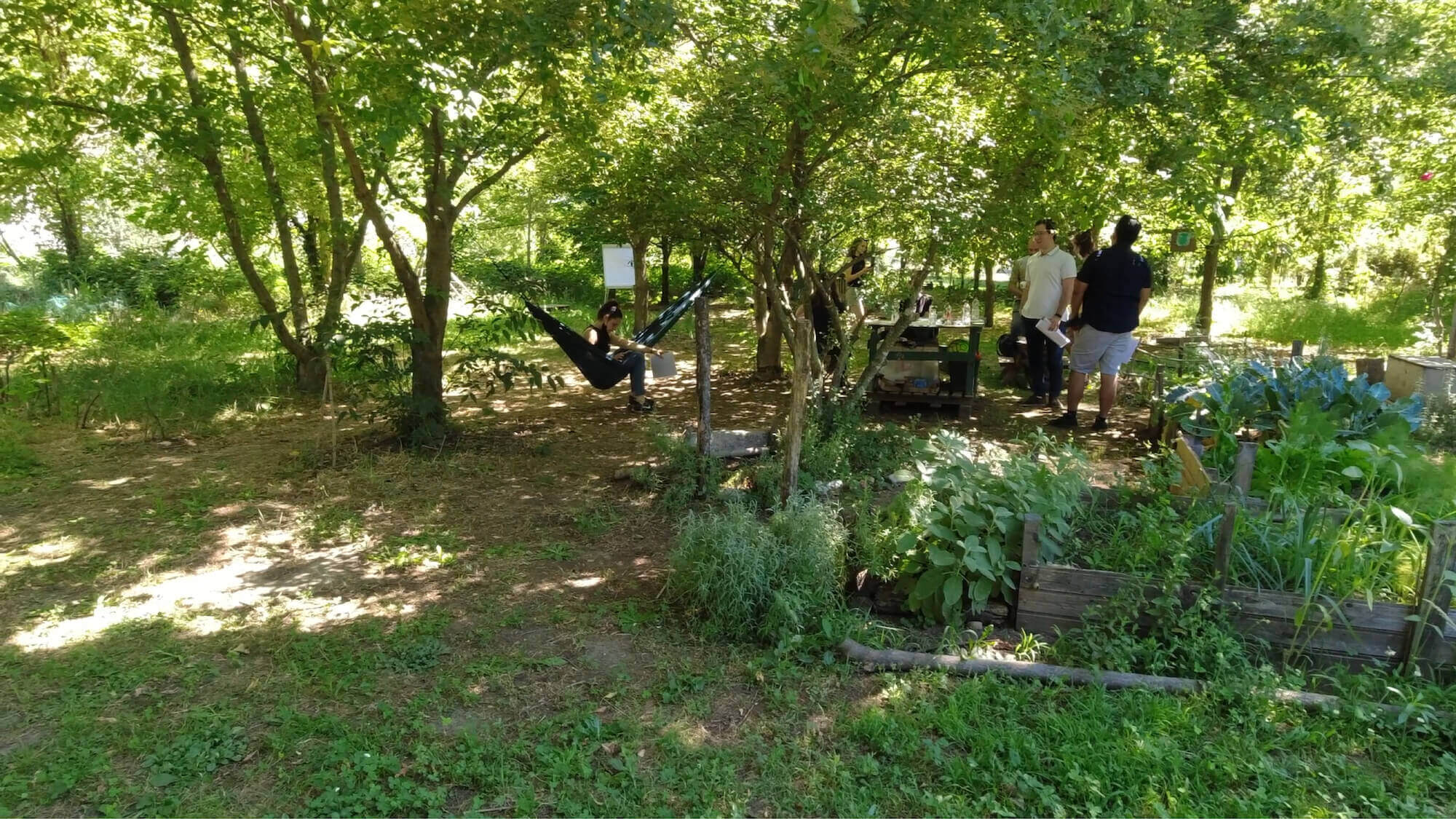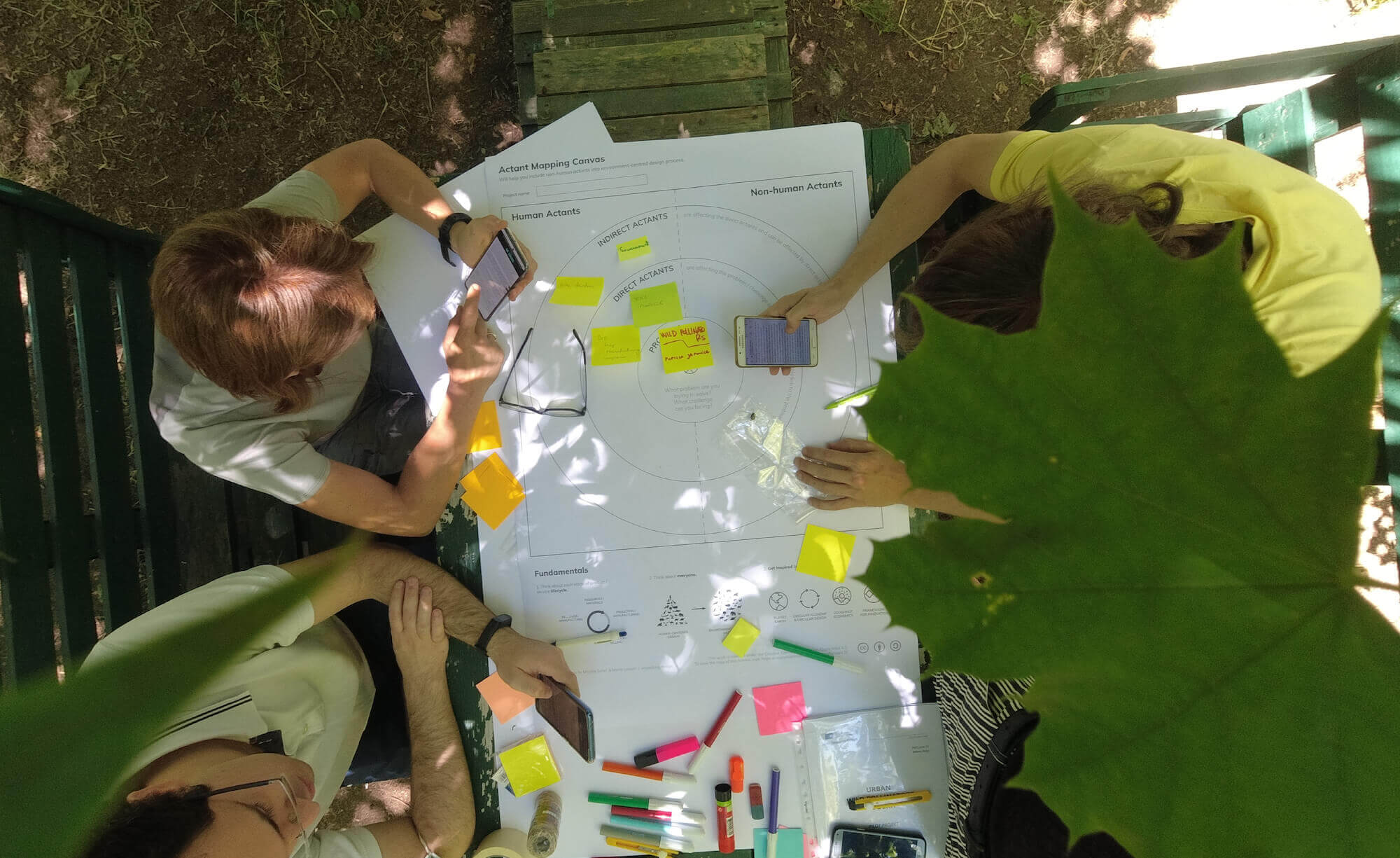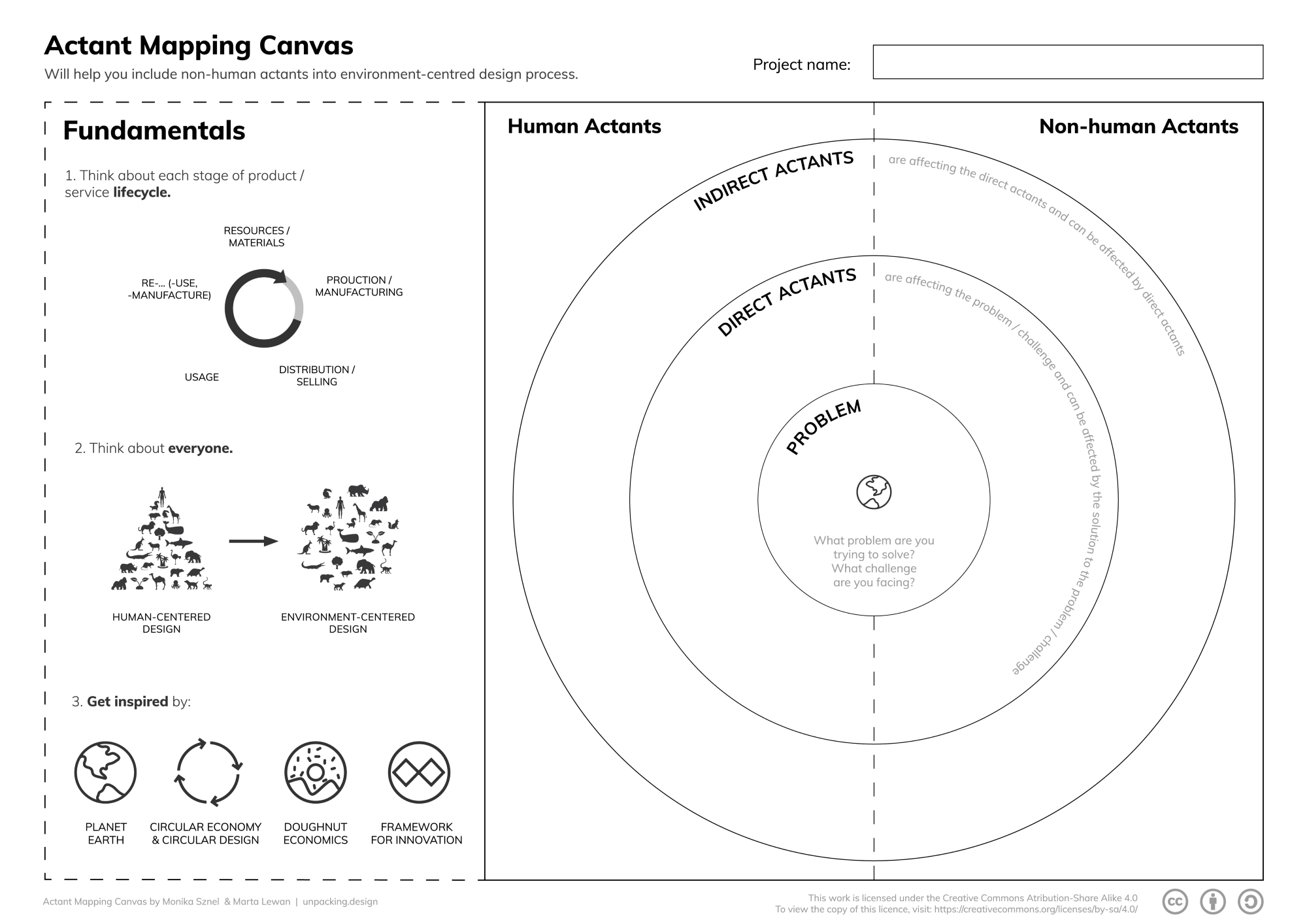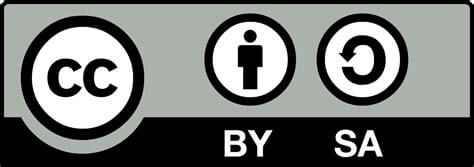
BiodiverCities
2021m. Milano – pilot
A pilot workshop was held in Giardino San Faustino, a community garden in Milano run by cooperative Cascina Biblioteca along with six local no-profit associations (stakeholders). Participants from various backgrounds (students of diverse fields and country of origin, volunteers) were invited to test out the toolkit and the workshop framework. Hosting the workshop in the garden allowed the participants to observe the co-existence of urban environments and nature ecosystems first-hand. After an introductory guided tour around the area, the workshop program was divided in three parts: exploring human-insect interaction experiences, discussions about ecosystem issues, and testing out the toolkit.
 Giardino San Faustino. Main area where the pilot took place.
Giardino San Faustino. Main area where the pilot took place.
Human-insect interaction
Artificial bee contact
Activity aimed to recreate the emotional experience of the participants when a bee is present nearby via audio and haptic methods in a safe and controlled environment. Participants were listening to a three-dimensional audio of a flying bee, encouraging the perception that the bee is buzzing around the listener. Participants were blindfolded to enhance the sound perception. At the same time, the activity supervisor would touch the participant’s hand with an artificial insect, to mimic the haptic experience. The session lasted around 1 minute. During the reflection part, participants were asked to evaluate their experience, indicating separately sensations of the listening experience and the haptic part. Afterwards, everyone was invited to share their experience and participate in a discussion.
Outcomes of this research: The teams indicated different experiences based on the environment they grew up in. The first group, comprised of respondents who live or have lived in a rural context, expressed more positive reaction towards insects and their presence. They were also more inclined to repopulate urban environments with pollinating insects and biodiversity. The other group – people grown up in urban context - was more reluctant to accept insects and their presence. They felt more afraid of something they do not know and some of them tried to avoid it as much as possible. Some participants expressed more sensations of fear. For them, listening twice to the 3D audio source decreased their sense of annoyance, along with seeing in person real hives during the tour of Giardino San Faustino helped them to prepare mentaly.
 Participants are listening to the audio
Participants are listening to the audio
 While listening to audio, participants are touched with artificial
insect
While listening to audio, participants are touched with artificial
insect
Human-ecosystem interconnectedness
Discussion with Actant
Mapping Canvas
Participants were given an introduction talk about wild pollinator importance to our ecosystems as well as relevant issues accounting for their decline today. The short lecture was useful to form a basic background knowledge and insights about current attitudes towards pollinator decline and biodiversity, harmful solutions that are offered in the market, and systemic changes that are necessary in today’s societies.
To encourage active engagement with the topic and information, a peer discussion format was used around different types of problems: use of pesticides, landscape fragmentation, invasive species. Participants were asked to use an Actant Mapping Canvas template as a tool (developed by Monika Sznel & Marta Lewan from Unpacking.design), an approach based on environment-centric (or planet-centric) methodology (Sznel, 2020). The task was set to to map out all the actors (humans and non-humans) that affect or are affected by a problem directly (effects that are felt soonest and for which the connection to the problem is obvious) and indirectly (second chain of results after direct actors are affected and connection is not that obvious).
Outcomes: In the beginning, the Actant Mapping Canvas was complicated to understand, but with the help of supervisors all teams filled the templates while discussing about how each actor of specific problem is affected. Teams were able to allocate and identify direct and indirect effects of previously mentioned problems on the whole ecosystem. This resulted in deeper understanding about interconnectedness and complex human and non-human
 Discussions with Actant Mapping Canvas
Discussions with Actant Mapping Canvas
Testing the toolkit
Participants were given the materials and instructions to assemble and prepare the two main elements of the toolkit – the insect hotel and the ground unit. The toolkit is released open-source under CC BY-SA license.
The Insect hotel was designed according to the requirements (MacIvor, 2016; Beefoster, n.d.) to host several different insect species for one year, after which it should be replaced. The main material – craft cardboard – was infused with natural bee wax to become weather-proof and help retain nesting cavities dry. The structural parts were designed to be cut out from one A1 sheet and joined using 3 pairs of M4 bolts and nuts. The inner nesting cavities can be created using paper or natural hollow elements, such as reeds or natural straws.
The ground unit was designed to act as an aesthetic element along the edges of wild meadows, to communicate the intentional wilderness preservation in the cities and cue citizens the signs of care. This approach is based on findings that more ecologically diverse places are perceived as messy because they do not contain indicators of human intervention and control (Nassauer, 2011; Qiu et al., 2013).
Outcomes: Participants assembled and installed the insect hotels nearby wild meadows in Giardino San Faustino. With the ground units participants created different shapes, filled them with the soil and used as decorative or functional elements for the wild meadows.
 Teams are assembling the insect hotel
Teams are assembling the insect hotel
 Creation of ground units. Work in progress
Creation of ground units. Work in progress
Conclusions
The pilot was carried out to test the workshop activities and the toolkit, and gain insights for further project directions.
With the artificial bee contact activity it was found that citizens from different urban backgrounds have contrasting experiences towards insects and close contact with them. People from urban context expressed more fear and were more reluctant to accept the idea of more insects in the cities. There is no doubt that citizen’s acceptance of insects is an important point to be considered in more ecologically diverse urban development and should be addressed with great attention.
Using of Actant Mapping Canvas proved to be an effective way to discuss about interconnectedness of the ecosystems and relating problems. A more elaborated explanation on how to fill the templates (using examples) is necessary to cause less confusion in the beginning.
The toolkit building session provided valuable feedbacks about further design developments that should be considered, such as more effective creation of nesting cavities or more elaborate explanation about the ground unit and their shape requirements. Overall, the toolkit proved to be easy and clear to assemble and use, with materials that can be easily found in different places.

Reference list
Beefoster. (n.d.). Beestra vs. bee hotels. Retrieved July 13, 2021, from https://www.beefoster.com/beestra-vs-others.html
MacIvor, J. S. (2016). Cavity-nest boxes for solitary bees: a
century of design and research. Apidologie, 48(3), 311–327.
https://doi.org/10.1007/s13592-016-0477-z
Nassauer, J. I. (2011). Care and stewardship: From home to planet.
Landscape and Urban Planning, 100(4), 321–323.
https://doi.org/10.1016/j.landurbplan.2011.02.022
Qiu, L., Lindberg, S., & Nielsen, A. B. (2013). Is biodiversity attractive?—On-site perception of recreational and biodiversity values in urban green space. Landscape and Urban Planning, 119, 136–146. https://doi.org/10.1016/j.landurbplan.2013.07.007
Sznel, M. (2020, May 25). Tools for environment-centered designers:
Actant Mapping Canvas. Medium.
https://uxdesign.cc/tools-for-environment-centered-designers-actant-mapping-canvas-a495df19750e








